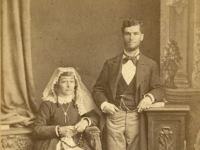Vladimir (?) Barkanov (or Barkanoff – in French transliteration), had one of the very first photo-ateliers in Tiflis, which was in operation by 1865. Despite the fact that Barkanov is included in Vahan Kochar’s encyclopaedic book ‘Armenian photographers’ (Yerevan, 2009), there is no evidence to support claims of Armenian ethnicity. It is most likely that Barkanov was of Jewish origin as the surname is common to Jewish families living in the Caucasus as well as Russia and Ukraine. Initially based in Kutaisi, in the northern part of Georgia, Barkanov moved to Tiflis, possibly in the late 1860s. Judging from the stamps on his cabinet cards and carte de visite portraits, he was very adept in self-promotion and quickly rose to the ranks of most prominent in the Caucasian capital. He actively participated in many international fairs and exhibitions, winning a number of medals: from the Societe Francaise in 1866, Vienna Universal Exposition in 1873 and from the Russian photographic society in the University of Moscow in 1872. His studio was located in the prestigious commercial house of Kharazof, in the centre of Tiflis and later, near the ‘Erevan’ square, both of which constituted the commercial heart of the city. As surviving portraits demonstrate, between the 1860s and the 1880s, “Photographie W. Barkanoff’ was the studio of choice for the city’s elite, foreign visitors and officials. It appears that the photographer had close ties with the local government, leading him to become one of the official war photographers during the Russo-Turkish war of 1877-78. Although he photographed numerous public events and some corners of Tiflis, Barkanov seems to have focused primarily on studio portraiture, leaving other genres such as landscape, ethnographic and historiographic photography to his competitors Dmitri Ermakov and Engels. The best of Barkanov’s portraits, like the ‘Portrait of Madame Kekel Papovyants’ from Lusadaran’s collection are marked by subtle and very even lighting techniques, depth of the space and restrained compositions that, typically for late 19th century photographers, allude to royal portraiture.
Vigen Galstyan, 2014





